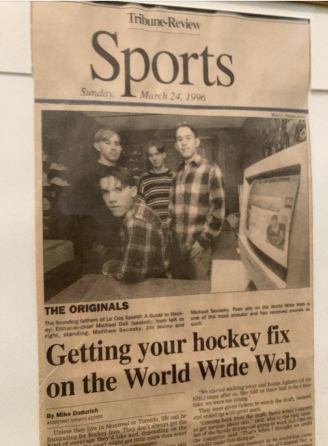
Tales of Journalism Past, Present and Future
December 17, 2021
It’s the holidays, and like Charles Dickens’ A Christmas Carol, I want to share a tale of Journalism Past, Journalism Present and Journalism Yet to Come.
Let’s start with Journalism Past. For this, I take you way back to June 1994. That’s when four high school friends started a publication covering the National Hockey League. They didn’t like the way traditional outlets like The Hockey News covered the league, and they thought they could do it better.
There really weren’t many websites around back then (Netscape Navigator wasn't released until October 1994), so they started out on Usenet groups and asked people to give them their email address (newsletter subscription model!) to receive a .txt file every two weeks, or their mailing address to get it delivered via snail mail.
When web browsers arrived, these four young lads created one of the first hockey sites in existence. The NHL joined the internet a little while later, and literally stole the kids’ content and used it on the front page of their site. The World Wide Web was more World Wild West back then, to be honest.
Being at the forefront of Web 1.0 had its advantages. The kids gained a very large audience for their content – millions of page views a month within a few years – by mixing smart hockey analysis with some wacky hijinks. They drove a station wagon from Pittsburgh to Hartford to cover the NHL Draft (thanks for letting us borrow the car, Mom!), only to have their press passes taken away from them because they were deemed “too young” to cover it. The Shaft at the Draft, however, let to bigger and better things. They were offered web hosting for free from a place called Canadas.net (it was pricey back then if you needed more than Geocities could offer!) and were invited to have their own “keyword” home on AOL Canada.
They soon had unpaid correspondents in every NHL city (user-generated content model!) who just wanted to be a part of what these kids were building. Some of them even got press passes, which was unheard of at the time. There were Cool Sunglasses awards. And media coverage. And groupies in Sweden. Life was good!
But, alas, all good things must come to an end. What used to be fun and enjoyable turned into a slog. It didn’t help that the NHL became pretty much unwatchable in the late 1990s thanks to clutching and grabbing and the left-wing lock. And besides, there was no real way to make money on the Internet back then if you were four college kids with a passion for hockey. So they closed up shop, got real jobs that paid real money, and occasionally think back somewhat fondly on all of those hours they wasted, err, spent at Penn State University watching the CBC on cable TV and taking advantage of the university’s T-1 internet connection.
A Tale of Journalism Present
About a decade after that hockey publication rose to prominence online, another group of high school friends created their own sports publication during an era now known as Web 2.0. That site was called Bleacher Report.
One of the founders, Dave Nemetz, described the site’s evolution like so:
- The concept started as an amateur sports site run by a group of friends.
- While still at an early stage, the idea pivoted into an online community for sports fans, driven by user-generated content.
- Over several years, the site evolved into the professional sports media company it's known as today.
Around this time in 2006, the Internet was becoming established, and the major media companies, like ESPN, and the major sports leagues were starting to get their act together online. But there was still room for newcomers like Bleacher Report and Barstool Sports to enter the arena and grab a share of the market.
And grab they did. Bleacher Report figured out UGC on a large scale, and also learned how to use SEO to its advantage to bring in massive amounts of traffic. It then realized that newsletters could get those eyeballs to keep coming back to them again and again.
They also figured out Series A funding – an unheard-of concept for online sports startups just 10 years earlier.
Oddly enough, the founders’ reign as owners lasted about the same length of time as the Web 1.0 hockey crew. But instead of just shutting things down, they cashed out to the tune of about $175 million.
A Tale of Journalism Yet To Come
A few weeks ago, one of the founders of the Web 1.0 hockey site (me) invited one of the founders of the Web 2.0 sports site (Dave Nemetz) to chat with our NewStart students about all things entrepreneurship.
During the chat I snuck in a question about the future of sports journalism. Nemetz lived through the starting and selling of a sports site in Web 2.0, and we’re all seeing the successes and struggles of newer sports sites like The Athletic. So what is next? What does the sports site of Web 3.0 look like?
“If I was advising someone or talking to someone, I think the DAO (Decentralized Autonomous Organization) model could be really interesting to look at for sports,” Nemetz said. “I know quite a few people who are either starting DAOs or involved with DAOs to raise money to buy a sports team or buy a piece of a sports team ... I’m not sure they’re going to be successful, but maybe in the long run. But I think sports is such a category that people feel such strong ownership over and kind of feel so invested in already. They don’t say, ‘My team won.’ They say, ‘We won.’ That space is kind of ripe for giving more ownership to the community and giving more say to the community in how a brand can be built. That’s something we even thought about in the early days of Bleacher, and we thought about how can we share ownership with the community or give them the ability to share in the upside, but the structures just weren’t there, and ultimately we moved into a more traditional direction.”
For those who aren’t keeping tabs on DAOs yet, or are still confused by their actual existence, this piece from Jarrod Dicker may help explain things.
And that article from Dicker about Creator DAOs leads nicely into Nemetz’s final thoughts on what the next innovative sports offering might be.
“I’m very bullish on the creator economy and the ability for individuals to become storytellers and creators to build a following,” Nemetz said. “So many athletes have done that and built their social followings and built massive brands around themselves. But I think there’s more of an opportunity to tap into that storytelling directly from the athletes, maybe by going toward younger athletes or thinking about how to remix that storytelling in different ways and take it off of Twitter, off of Instagram, into a different space. It has been tried before — there was The Players’ Tribune and other places — but I don’t feel like it’s really been quite figured out yet — how to get that story right from the athletes and how to follow right along with them on their journey.”
As you now know, the journey of online sports journalism has been quite an evolution over the past 25-plus years. And from the looks of it, it's a journey that is far from over.
A Correction
This is the 100th edition of the NewStart Alliance newsletter. Yay!
Out of the 99 previous newsletters, I can only remember one time where I had to make a correction. Now we’ll make that two.
In our last newsletter I discussed the great work that Alain Begun is doing with the River Journal and River Journal North publications. As someone who is constantly discussing weekly newspapers, I mistakenly referred to the RJ and RJN as weeklies. They are, however, monthly publications. Also, Begun’s partner in the River Towns Music Festival is Liz Goodyear of The Live Goods.
An updated version of the newsletter can be found here.

